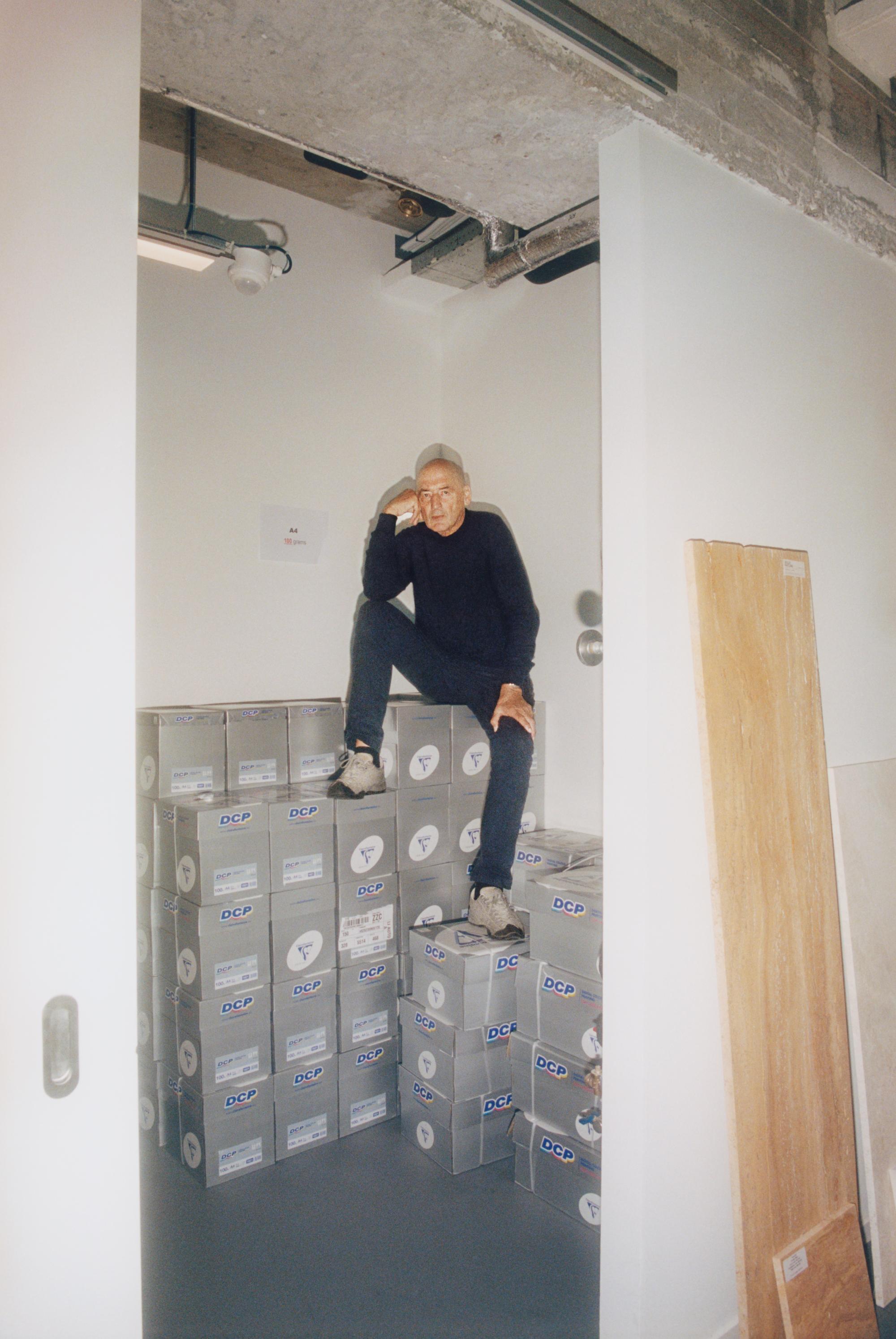
Rem Koolhaas photographed by Francesco Nazardo for PIN–UP
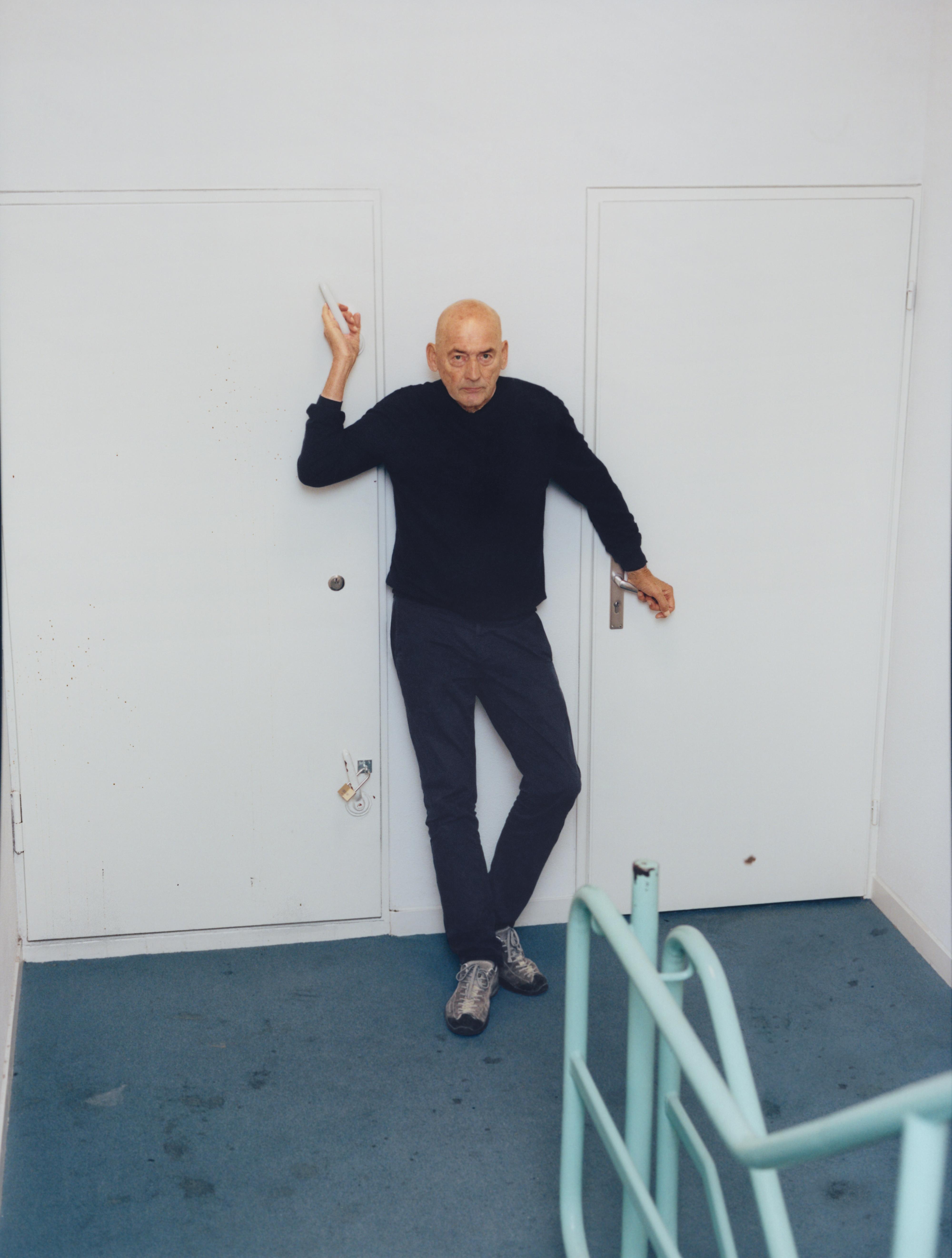
Rem Koolhaas photographedy by Francesco Nazardo for PIN–UP
Rem Koolhaas is a global architect of the first order. His designs, unorthodox working methods, and theoretical thinking have helped define the state of the architectural profession, bridging the 20th-century with the 21st. His projects span the globe, from Beijing to Moscow, Vegas to Milan, and Berlin to Taipei. But more than any contemporary non-American architect, Koolhaas’s thinking and approach to design have been shaped by urban, social, and cultural developments in the U.S. Whether it’s the commanding grid system of Manhattan, the psychology of shopping, big box architecture, industrial farming, or the urban condition of downtown areas of North American cities like Dallas or Atlanta. Koolhaas and his collaborators from the Rotterdam-based Office for Metropolitan Architecture (OMA) have mined American tropes, exporting the resulting ideas out into the world through building, teaching, and books. The architecture scene in New York has been imbued with Rem Koolhaas’s theoretical disposition since the mid-70s, not least since he published his seminal 1978 book Delirious New York: A Retroactive Manifesto for Manhattan. He positioned the architectural development of New York as a project of pure irrationality carried out under the guise of market-driven utilitarianism, with Manhattan as the ultimate touchstone of the 20th century. Koolhaas entered architectural practice relatively late in life, after a stint as a journalist in his native Netherlands and a dalliance with screenwriting in early 70s Hollywood. Now in the sixth decade of his practice with OMA, and in the third decade of the 21st century, the Pritzker Prize-winning architect is looking back at the early days of his practice while keeping an eye firmly on what’s ahead: in 2024 he’s opening Countryside, The Future in Doha, Qatar. It’s the sequel to the exhibition that debuted at the Guggenheim in 2020, at the onset of the pandemic, in which Koolhaas examined contemporary notions of leisure, climate change, migration, artificial intelligence, and a deluge of other issues the world faces in the near future. In an age of increased cultural fragmentation and rising nationalism, Koolhaas remains defiant: “The relation to architecture that I want to maintain is a form of diplomacy.”

Rem Koolhaas photographed by Francesco Nazardo for PIN–UP
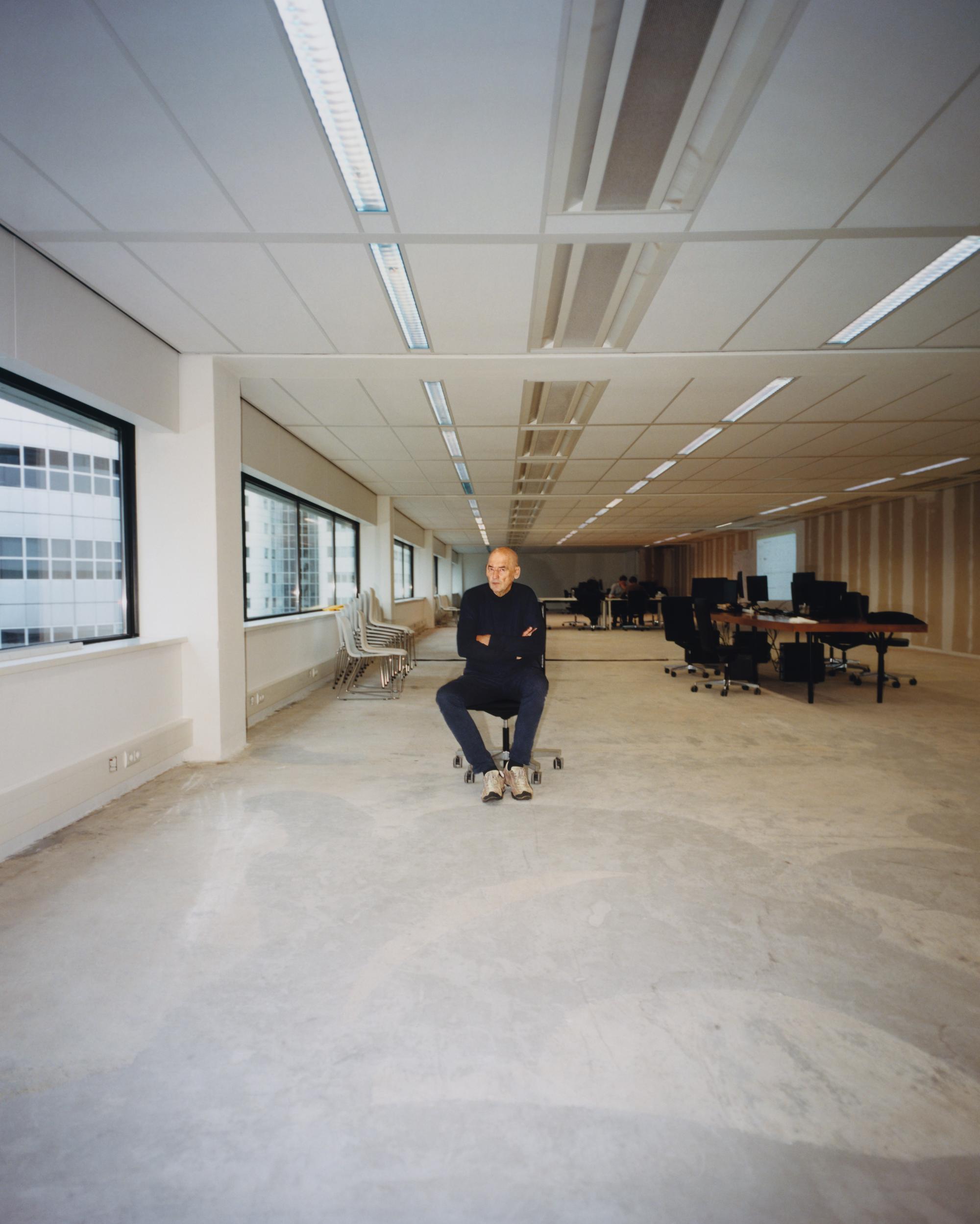
Rem Koolhaas photographed by Francesco Nazardo for PIN–UP
Emmanuel Olunkwa: Let’s start with the 1990s, because I’m interested in the spirit of innovation but also the anxiety around the new millennium and the cultural free fall that followed. What do the 90s represent to you?
Rem Koolhaas: For me, the 90s were interesting not necessarily because of what was going on in America, but because of what was going on in Europe. It was when I began to look away from America as a point of interest. In 1989, the Berlin Wall came down and the Soviet Union collapsed. It seemed to be a very direct encouragement of the European Union, which could be at the center of new creative policy and an agent in global politics. The power of Europe is not based on the physical power of armies, but on policy, rules for human interaction, freedom, and elections. So the 90s for me represented a rebirth for Europe. I also started to explore Singapore as a prototype, and then in the later 90s I began to look at China.
In comparison to the 90s, we’re seeing a decline in standards of living while conservatism is on the rise.
Cultural and social conservatism is looming. I think it’s partly because of patterns, and partly because of the whole structure we’ve created that limits our moving freely from one form of making to another. If you look closely at the culture of neoliberalism, what you see is that popular culture is increasing its engagement with commercialism and its alignment with the market economy. The role of the architect changed in the 90s. Before, architects, especially in Europe, mostly worked in the public sector, confident they were serving the public good. Reagan, Bush, Clinton, and 90s neoliberalism created a situation where they found themselves working for private interests instead, which was a fundamental change.
How did you balance taking on commercial work without compromising intellectual rigor, especially early in your career?
I’m a boomer, so for a long time I was really free from having to think commercially, which allowed OMA to take massive risks and invest the money we earned into creative endeavors and architectural research. But in the early 90s I spent an enormous amount of time with Bruce Mau working on the book S, M, L, XL, which almost caused the office to go bankrupt when it was published in 1995. We were partially bought by an engineering firm who gave us a manager. Eventually we regained our financial footing, and three years later we bought ourselves back. From that moment on we realized we needed our own management, because if we wanted OMA to do major constructions my indifference to money would be unsustainable. I have written a lot about the effect of neoliberalism and the change in priority of building for the private sector instead of the public. As an architect, I haven’t participated in building for a lot of private companies, so in that way you could describe me as old-school. My heart is in building for the public sector, with projects like CCTV, the Seattle Central Library, and the Qatar National Library. But I’ve had some interesting private-sector projects as well, like the Axel Springer campus in Berlin.
What made you lose interest in America?
My interest in America changed, especially after 9/11. I realized America was no longer to be counted on at all. I became much more politically active because I thought that, while 9/11 was tragic, ruining four entire countries was a lot more devastating, because there was no connection. It was an enterprise to destabilize the rest of the world. Americans were wrestling with issues that were maybe important for them, but they were being so destructive elsewhere and not contributing to the common good of the world. The sequence of presidents George W. Bush, Barack Obama, and Donald Trump is not a very politically credible situation.
How does this relate to architecture?
The relation to architecture that I want to maintain is a form of diplomacy. I see my role as creating connections between Europe, Russia, India, China, Africa, and the Arab world. We must communicate with Iran, Russia, and China and really consider what we mean when we say human rights, corruption, freedom of speech, free trade, and copyright. It’s explained by the type of projects I’ve taken on, working with Chinese state television and, until recently, with Russia. It’s why there’s a strong political dimension behind what I do. As we now close connections with China, Russia, and the Arab world, we’re creating this sense of narrowness that essentially reveals how we want to destroy China’s innovative powers.

EU Barcode, 2001. © OMA
When did you live in America?
From 1972 until 1980. I had a grant to go to America for two years under the Harkness Fellowship. You had carte blanche — you could either go to university or choose to do independent study. I spent a year at Cornell University and then the rest of the time in New York City, first as a fellow at the Institute for Architecture and Urban Studies. During that whole time, I was trying to think of what type of book I could write about New York.
Why New York?
The reason I wanted to do something about New York is because my initial impulse to practice architecture was influenced and triggered by the Russian architecture of the 1920s. In 1966, 1967, I went to the Soviet Union to do research and see what those architects had come up with and what their motivations were, which was compelling and convincing for me. I was not interested in the form or the language of Modernism at all, but more what it proposed, which was that cities could be abandoned and that families could live in alternative states where the architecture creates a new context and way of living. When I came back, I thought it would be interesting to write about New York because it’s a different modernity. But in 1972, when I came to America, the whole idea of Modernist architecture was under huge threat with the emergence of Postmodernism. Postmodernism in literature and art is a very sophisticated way of interpreting shifts in tone. In architecture, it became debased. You had to look more at context and history, and everything was entirely reduced to style. I was alarmed by the fact that Postmodernism had become the dominant ideology.
The ideological shift that happened in 1968 was echoed in 1989 in a similar way. And we’re still feeling the effects of 1989 in 2022.
Yes. What’s the difference between 1968 and 1989? In the 60s, critique was developed, sophisticated, and, I would say in retrospect, very fair. But of course part of this critique and the way we were governed at the time was also a critique of modern architecture, which backfired. You have The Death and Life of Great American Cities by Jane Jacobs in 1961, then you have Denise Scott Brown, Robert Venturi, and Steven Izenour’s Learning from Las Vegas in 1972, and there were more substantial responses as part of these critiques. My book Delirious New York was published in 1978, and it was both a response to and part of these movements.
It’s funny to think that people categorize Delirious New York as a book, because it felt like more of a mapping practice. You’re excavating and mining with language.
Yes, it’s really a mosaic with tiny morsels of information. One of the most difficult and irritating parts of writing is that you have to explain and show what happens in between. It’s so tiresome, which is why I decided to do a book entirely without the middle parts.
Did you have a publisher when you started writing?
[Laughs.] That’s a very good question. Because I knew my fellowship was running out and I needed to make money. I reached out to a few publishers, and an English guy working at a publishing house in New York named James Rames got back to me and paid an advance of 10,000 dollars. He was willing to bet on me without knowing me at all because we had a friend in common. At the time, it was the base for what you needed to live in New York, and then I made money giving lectures or selling drawings.
Drawings?
What, you don’t know this? There was still a market then for architectural renderings. The economy was very bad and there was a category of paper architecture and people who were interested in buying it.

Cover of Delirious New York by Rem Koolhaas, 1978; first edition. Courtesy of OMA

Rem Koolhaas, Elia Zenghelis, Madelon Vriesendorp, Zoe Zenghelis, Exodus, or the Voluntary Prisoners of Architecture: The Strip aerial view, 1972. © 2013 Rem Koolhaas. Courtesy of OMA

Rem Koolhaas, Elia Zenghelis, Madelon Vriesendorp, Zoe Zenghelis, Exodus, or the Voluntary Prisoners of Architecture: The Strip aerial view, 1972. © 2013 Rem Koolhaas. Courtesy of OMA
What was it like at the Institute for Architecture and Urban Studies while you were researching the book?
When I was there, it was under the directorship of Peter Eisenman, who was super important and informative. Kenneth Frampton and Denis Hollier, who was with Rosalind Krauss, were also there. They were incredibly suspicious of me given that I was dealing with Surrealism and Salvador Dalí as subject matter. [Laughs.] Rosalind told me, “I hate the Surrealist stuff you’re doing!” But there was Andrew McNair, who I was incredibly close to during the 70s, who became the editor of the institute’s magazine Skyline. It’s an interesting reference point for me, because Skyline was the institute’s B-movie — everyone was incredibly invested in being part of the A-movie, but the B-movie section of culture was open to the rest of the world.
What were you thinking about when you started writing?
I did extensive research, and my theory then was that, even before the 20th century, the explosion of technology, for instance electric lights and the elevator, became a big issue for the population. Some technology was tested in the form of amusement parks, which is why I have a long chapter on Coney Island in the book. I was able to do all this research because I had time to think and no obligations. I went to the public library every day to look through microfilms in the basement. While I was researching, I found this map of Coney Island from 1907, which showed the beach, and everything in between was essentially part of the conjoining theme parks — one side featured the Globe Tower, and I also discovered the plans they proposed for its design. The map was published in the New York Herald Tribune: it showed the conventional buildings in New York and then showed Coney Island and how it created its own purpose-built sphere.
This mapping strategy reminds me of Disney World.
It’s funny you say that, because I first came to America when I was 16 and wrote a novel about Disneyland. I had a subscription to National Geographic as a teenager, and there was an article on Disneyland which talked about its fake Matterhorn and the fake mountain climber from Germany they recruited to climb the Matterhorn — I think he did it at least twice a day. There was 15-year-old girl dressed as Tinkerbell floating on a cable over the entire Disneyland landscape. I wrote a novel about the encounter between the mountain climber and Tinkerbell called Johann in Disneyland, which was a play on Alice in Wonderland that gave it German distinction.
What’s your relationship to the concept of Disneyland, its enterprise, and corporate theory?
Disneyland is an ideology. I have to say I’ve always been interested in populism and popular culture, and I’ve always been sad and uneasy about the separation of architecture and popular culture, which is where my interest in writing Delirious New York came from. I was trying to prove that it was possible to combine popular culture with architecture, but it is also meant to look at architecture for elements of culture.
I would argue that good architecture is popular culture.
Which makes you an enlightened and sophisticated individual. Go tell Herzog & de Meuron that. [Laughs.]

The Seattle Central Library, detail, 1999–2004. Photography by Philippe Ruault. Courtesy of OMA
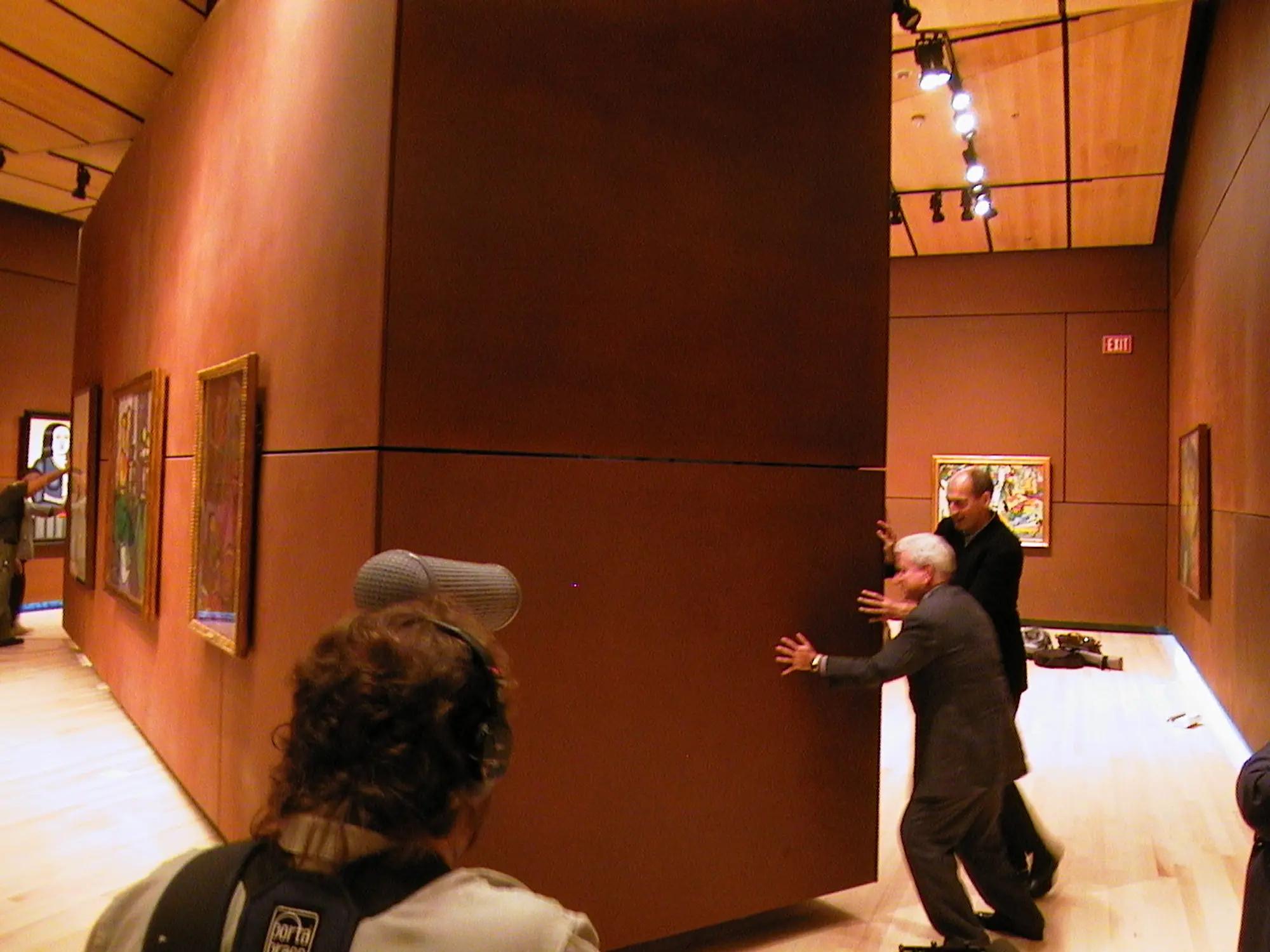
Hermitage Guggenheim, Las Vegas, 2000–01. Photography by Ari Macropoulos. Courtesy of OMA
What about building utopias? How, for example, does Le Corbusier relate to New York? Or Soviet ideas about building a new, better world?
There are a few examples in Delirious New York. For instance, I wrote about the relationship between Dalí and Le Corbusier, whom I’m incredibly skeptical of but still admire. In terms of Russia, there is a picture in Delirious New York from the opening of Radio City Music Hall. The slogan was “A night at Radio City Music Hall is as good as a month in the country.” Culture generally had this dichotomy of night and day that they applied to everything at the time, and Radio City used lighting that looked like the sunrise and sunset. The impresario behind the building, Samuel “Roxy” Rothafel, then went to Russia and spoke to Konstantin Melnikov, an influential architect who proposed a plan of motel-like structures to be built around Moscow where Soviet workers could rest in an artificial coma on slanted beds, with an air-conditioning system fed with artificial gasses and a recorded soundtrack of chirping birds.
So the setting was engineered to produce euphoria?
Yes, exactly. Rothafel spoke to these people in the midst of building the venue and they decided to introduce nitrous oxide — laughing gas — into Radio City’s ventilation system. That’s what links the architecture of New York to what was happening in Russia at the time.
You lived in Los Angeles in 1974. What did you think of the city conceptually and architecturally?
It was unbelievably beautiful in my eyes. I loved it. You could move around in an incredibly free manner. It was wonderful to have days that consisted of periods of isolation and meditation, which worked really well for me at that point. I lived there for four months writing scripts. I had a friend who was a filmmaker, Rene Daalder, who would later direct a film called Massacre at Central High, and because I had written scripts with him before I studied architecture, we became friends with the director Russ Meyer. We wrote a script together for him in 1974. He never filmed because it didn’t turn out to be the most interesting piece of writing.
Where did your fascination with storytelling come from?
My father was a writer, and it’s always been something that came naturally to me. What I discovered working on Delirious New York is that writing is basically like making a film: there are these elements you’re trying to find an interesting way to connect by choosing a captivating sequence. Architecture functions in a similar way because architecture and narrative are very close as forms.
What makes architecture modern in 2022?
Ten years ago, my answer would have been that if architecture is part of a process of modernization, it’s modern. But I think that modernization has changed a lot because of global warming. There is a very important shift that has become reflected for us in our work, which I find very exciting, a radical change where we have an agenda that we have to adhere to, which I support wholeheartedly. There’s an entirely different intelligence at work now, with an emphasis on issues that are much less concerned with formal or intellectual expression and more focused on the use of standards, techniques, and materials. It’s about finding a way to embrace a new language which is more than just the expression of good intentions.
How do these new standards materialize?
At every level. In terms of material and color for instance. If solar panels are black, it’s because it makes them the most efficient, so that means we already have a different sense of the value of black, and there’s an immediate effect on which color schemes we are able to use, design, and construct. This is a very concrete and seemingly trivial thing maybe, but I think it’s important. Historically at OMA, we’ve been interested in structural engineering and in making it more daring and radical, but now there’s another category of engineering we’re working on with more intimacy. During the design and construction of CCTV in China, we did things we couldn’t do before, simply because the technology had advanced rapidly — suddenly we had computing power to work out the minute details, which was exciting. But now ambitions are different, and we’re more concerned with stressing the limits of environmental engineering — it’s a massive change!

Rem Koolhaas photographed by Francesco Nazardo for PIN–UP 33.
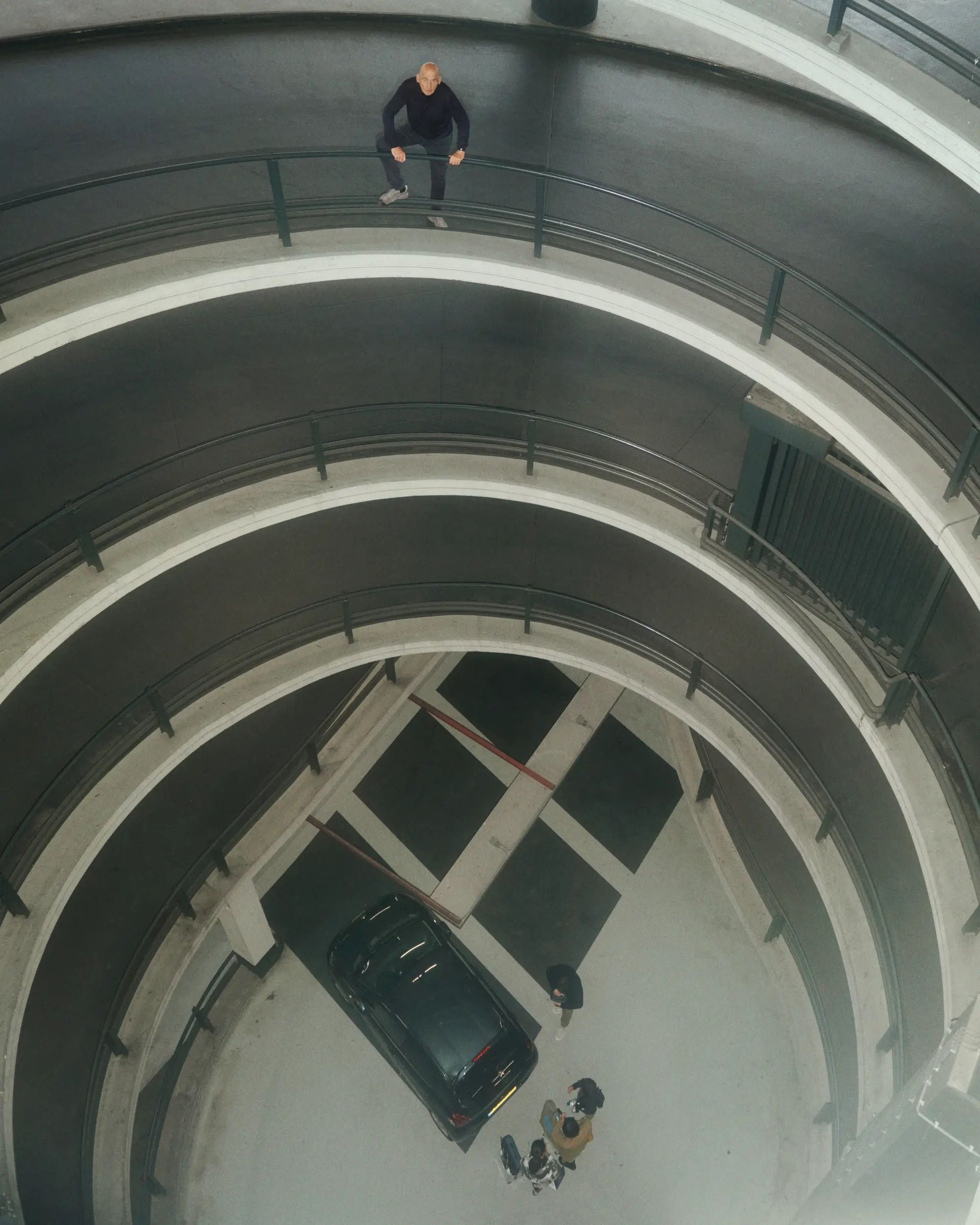
Rem Koolhaas photographed by Francesco Nazardo for PIN–UP 33.
What is environmental engineering?
What do you do with air? What’s air conditioning? Is it an inevitability or is it a wasteful way of ensuring a climate in a situation where much more natural possibilities exist? While doing research for Countryside, The Future, I became really interested in the politics of all these enormous out-of-town structures that are being built, which are of a size and scale so big that they’re now unthinkable in cities. Outside Reno, in Nevada, there’s the Tahoe-Reno Industrial Center, or TRIC, an incredibly beautiful landscape where all the major American corporations are building at an unimaginably large scale —Tesla’s battery factory, distribution centers, etc. These buildings are fascinating not only because they’re bigger than anything we’ve seen but because they aren’t buildings for people, they’re made to house machines.
What exactly interests you about them?
It’s a new form of commission. It’s enormous in terms of scale and presence, but with TRIC there’s little concern for sustainability and how buildings can be intelligent and responsible. It’s very clear that there is a vast and unexplored territory of where this problem becomes central. At this point in my life, I want to work in and address this context, because I’ve spent the majority of my career as an architect thinking about issues of approach, entrance, vestibule, corridor, staircase, trying to make them relatively welcoming and extract the ultimate pleasure from those ingredients and organize them in interesting ways. It’s very liberating to ditch that entire human domain and think about architecture without the need to please or accommodate human beings.
What’s the difference between building for a machine and building for a society that is in the process of eventually meeting the machine?
I assume that those buildings are necessary, or will be in the future, because however we might respond to global warming, some type of large-scale technical apparatus will be necessary.
Do you think those buildings can only exist where they’re currently located, in the desert in remote locations, far away from human habitation?
That’s a good question. They’re too big for cities, but whether they’re being built in the best place right now is debatable. Should we devise alternative systems and tools to regulate their temperature besides air conditioning? You’re making a structure to house machines, but you have a human being maintaining the operating system, who can’t stand a temperature of more than 24 degrees Celsius. A machine can stand 400 degrees, but the human being would die in those conditions. Do you cool the entire building down to accommodate the human’s needs, or do you impose the equivalent of a moon suit for the human to stand the temperatures and working conditions, which means 0.1 percent of the energy? For me, it’s a radical and interesting question that engages a conversation about climate in a social way. We’re currently looking to see if we can inject a hybrid of a museum and data center into an extremely old city in Italy and create new typologies which address the same issues, but at a different scale.

Aerial view of the Tahoe Reno Industrial Center (TRIC), 2017. Photography by Evan Petty. Courtesy of OMA
Was the Whole Earth Catalog ever an important tool in your practice?
You couldn’t live in the 1960s and 70s without encountering and sympathizing with the material. To start with there were parts of it I found silly, hippie, and naïve, but then I moved to Britain, an Anglo-Saxon country, so I became less European in a way, and then I went to America, which was very important because I was able to get to know that hippiedom was only part of a longer and deeper streak in U.S. culture that includes Thoreau and Whitman. Living in America, I realized it wasn’t a superficial movement at all, but that it introduced ideologies which, though they were driven by imagination, were actually backed up by science. And they continue to run very deep.
This makes me think of how diagrammatic Countryside, The Future was. The way it presented knowledge reminded me of a natural-history or science museum. Within the museological context, we think of the history of the environment as something that happened to us over time, through little or no fault of our own. The show directed our attention to problems we’ve created ourselves.
You’re right, we’re now doomed to document our interventions, but we do it with less innocence. Fifty years ago, we thought we could do no harm, but now we are convinced that everything we do contains an element of evil.
What changed?
We were confronted with the evidence. I started studying architecture in 1968, at the Architectural Association in London, a school that at the time was largely occupied with thinking about how to build in Africa. In the late 60s, as a part of the student unrest and dissatisfaction with governance, there was a deep awareness that we were working toward a crisis in the field of architecture. Everyone was thinking about it. The unfortunate thing that happened through Reagan, Thatcher, and the fall of communism was that the market economy became the dominant ideology of how things should be run or left to chance.
Was the 1968 uprising in Europe similar to the one in America?
1968 in America and Europe were similar, but in the States it was maybe more concerned with race and Vietnam, while in Europe it was more about disorderly governance.
How did that anxiety materialize in European politics?
In 1972, the Club of Rome published Limits to Growth, the first compelling report about global warming and what we were doing to the Earth. It’s still incredibly eloquent and prescient. The authors described what needed to happen to avoid the imminent crisis and confronted every government with a list of interventions needed on behalf of the environment — because in the 70s there was still the assumption that governments were the entities that were most responsible for societies. Then came Reagan, Thatcher, and their idea of the market economy. They insisted on smaller states and deregulation. It was a mistake on their part, because it could have been an opportunity to keep the climate under control — there was a moment when climate could have been addressed, as of 1972, when it was taken seriously for the first time. But the idolatry of money of all the governments undermined that insight. And when, in 1989, the Soviet Union collapsed, and with it the idea of a state-planned economy, everyone in America said, “See, you cannot organize a state at that scale because it doesn’t work. We need to rely on the market.” So we wasted more than three decades, to the point where the situation has now become much more dramatic, and we have to negotiate the politics of extreme weather and rising temperatures. If you look at this sequence, it’s stunningly clear where we’re about to go.
Now that you’re dedicating your practice to teaching, curating, and research, do you even think of yourself as an architect?
Over time I’m thinking of myself less and less as an architect. I originally decided to enter architecture because I saw opportunity. Everyone has different interests. I definitely have an enormous interest in spending time alone writing and thinking, while trying to resolve problems within current work situations. However, I’m extremely eager to interact with human beings and to learn, and one of the things about architecture is that it places you in unfamiliar contexts and settings where you have to figure it out and basically start over every time. It requires you to stay sharp and consistently keep learning. When I was younger, I was thinking about what the most interesting thing for me would be to do in the long term. Would it be better for me to be a jazz musician at age 55, or a writer at age 60, or an architect at this age, where I still encounter those different mediums in this singular role?
Did you always have that kind of clarity?
I postponed practicing architecture until kind of late. I was 32 when I published Delirious New York, and it wasn’t until 1980 or 81, when I was 35, that I began thinking about being a practitioner and having an office. That’s when I started, which means I’m still fresh. [Laughs.]
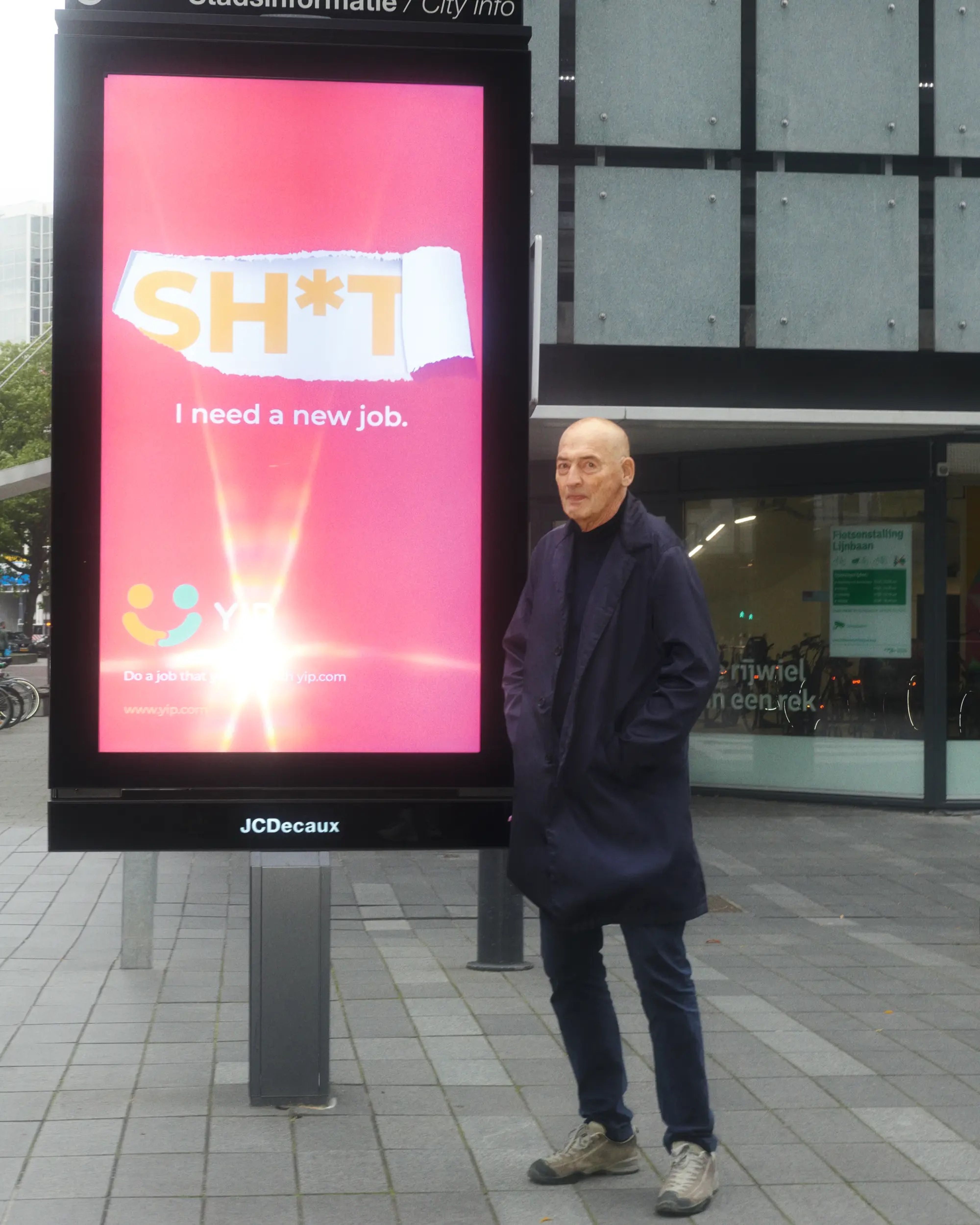
Rem Koolhaas photographed by Francesco Nazardo for PIN–UP 33.